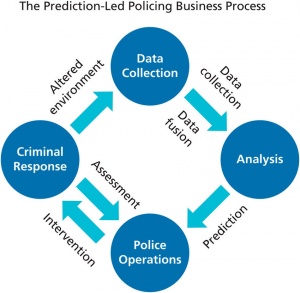Predictive Policing
Contents
Overview
Predictive policing is a term used to describe the application of analytical techniques on data with the intent to prevent future crime by making statistical predictions. This data includes information about past crimes, the local environment, and other relevant information that can be used to make predictions about crime.[1] It is not a method for replacing traditional policing practices such as hotspot policing, intelligence-led policing, or problem-oriented policing. It is a way to assist conventional methods by applying the knowledge gained from algorithms and statistical techniques.[2] The utilization of predictive policing methods in law enforcement has received criticism that it challenges civil rights and civil liberties, and its algorithms could exacerbate racial biases in the criminal justice system.[3]
In Practice
Predictive policing practices can be divided into four categories: predicting crime, predicting offenders, predicting perpetrator's identities, and predicting victims of crime.[1] It can also be categorized into place-based, which makes geographic predictions on crime, or person-based in which make predictions about individuals, victims, or social groups involved in crime. [4]

Process
The practice of predictive policing occurs in a cycle consisting of four phases: data collection, analysis, police operations/intervention, and criminal/target response.[1][4] Data collection involves gathering crime data and updating it regularly to reflect current conditions.[4] The second phase, analysis, involves creating predictions on crime occurrences.[1] The third phase, police operations, also called police interventions, involves acting on crime forecasts[1]. The fourth phase, criminal repose, also called target response, refers to law enforcement reacting to the implemented police interventions.[1] This may include the criminals stopping the crimes they are committing, changing locations of where the crime is committed, or changing the way they commit a crime. Thus, making current data unrepresentative of the new environmental conditions, and the cycle begins again.[1]
References
- ↑ 1.0 1.1 1.2 1.3 1.4 1.5 1.6 Perry, W., Mcinnis, B., Price, C., Smith, S., & Hollywood, J. (2013). Predictive Policing: The Role of Crime Forecasting in Law Enforcement Operations. DOI:10.7249/rr23. Retrieved from https://www.rand.org/pubs/research_reports/RR233.html
- ↑ Meijer, A., & Wessels, M. (2019). Predictive Policing: Review of Benefits and Drawbacks. International Journal of Public Administration, 42(12), 1031-1039. DOI:10.1080/01900692.2019.1575664. Retrieved from https://www.tandfonline.com/doi/full/10.1080/01900692.2019.1575664
- ↑ Lau, T. (2020, April 01). Predictive Policing Explained. Retrieved from https://www.brennancenter.org/our-work/research-reports/predictive-policing-explained
- ↑ 4.0 4.1 4.2 Brayne, S., Rosenblat, A., & Boyd, D. (2015). Predictive Policing. DATA & CIVIL RIGHTS: A NEW ERA OF POLICING AND JUSTICE. Retrieved from https://datacivilrights.org/pubs/2015-1027/Predictive_Policing.pdf.